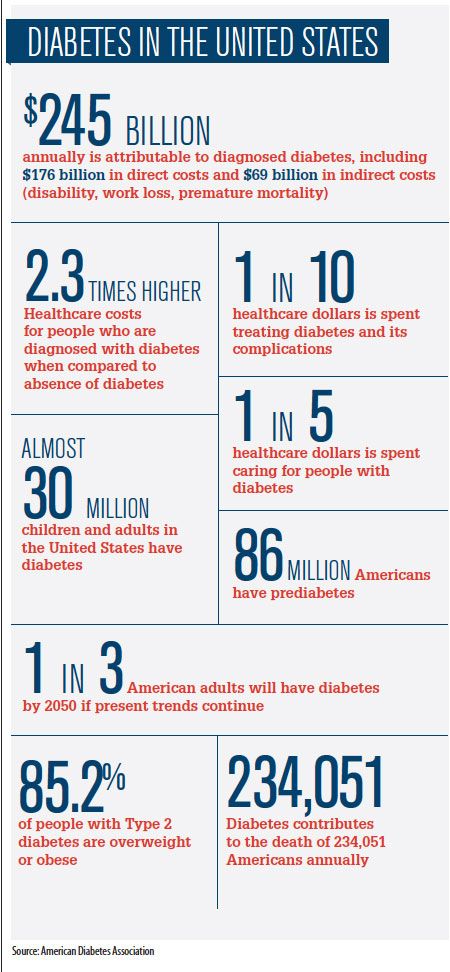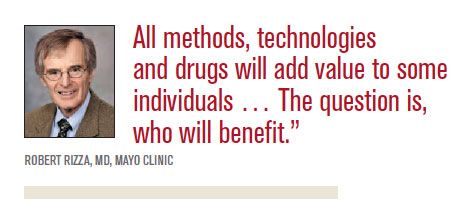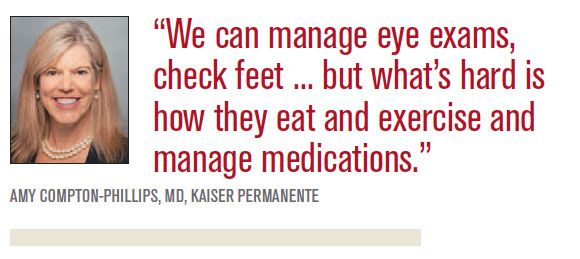Top trends in diabetes management
As the number of people with diabetes in the U.S. continues to climb, plans and integrated health systems are employing personalized strategies to help manage the disease.

From Verizon’s on-site biometric screenings, physical activity challenges and weight management program to Kaiser Permanente’s leveraging of medical records to let doctors know whether diabetic patients are due for blood sugar testing, there’s a growing trend towards personalized strategies for managing diabetes.
This new emphasis has evolved as the number of patients with diabetes-a disease largely preventable with lifestyle changes-continues to rise sharply in the U.S. despite decades of intervention.

Petersen“The good news, and it arises from many factors, is the rate of complications from diabetes [such as heart attack and stroke] has fallen over the last 20 years ... but the bad news is there is more diabetes,” says Matt Petersen, managing director of medical information for the American Diabetes Association (ADA).
The Centers for Disease Control and Prevention predicts the number of new diabetes cases annually will nearly double from eight per 1,000 people in 2008 to 15 per 1,000 people in 2050, and one-third of U.S. adults could have diabetes by 2050 if the trend continues.
Related:Models for diabetes prevention go beyond traditional approach
Prevalence is expected to keep rising as the population of older Americans and minority groups at risk for Type 2 diabetes grows, and as people with diabetes live longer.
According to the ADA, the total cost of diagnosed diabetes in the U.S. rose to $245 billion in 2012, up from $174 billion in 2007. Of that, about $70 billion is related to indirect costs such as work absenteeism and lost productivity. People with diabetes are also far likelier to retire early.
Petersen cites significant remaining challenges. As the number of individuals with diabetes rises, so do problems associated with diabetes identification and management. Close to 30% of people with diabetes are undiagnosed, and a large percentage have the illness for several years prior to diagnosis, says Peterson. About one-third to one-half are not reaching glucose-control goals or they don’t have their blood pressure and lipids/cholesterol under control.
Against this formidable backdrop, in efforts to manage diabetes, Petersen says, “Anything that works for a particular patient is the way to go, whether it’s a paper log book or a smartphone.”
NEXT: The role of integrated health systems
Integrated health systems can play a big role

It’s no surprise that managing diabetes has become a top priority for health plans, often within the context of broader chronic-care efforts. Nationwide, average medical expenditures for people with diagnosed diabetes in 2012 totaled $13,700 per year, of which about $7,900 is attributable to diabetes, according to the ADA. That figure is roughly 2.3 times higher than what expenditures would be in the absence of diabetes, the ADA notes.
“Those are the costs to the managed care organization-and [diabetes] treatment costs are relatively low. It’s the cost of complications that drive this,” says Robert Rizza, MD, professor of medicine at Mayo Clinic and former ADA president.
Rizza also is former executive dean for research at Mayo Clinic, where his team sought to develop effective therapies to treat and prevent diabetes and its complications. He asserts that healthcare systems must put the pieces together, looking beyond broad performance measures like A1C-a blood test used to monitor the glucose control of diabetics over time-and instead create goals targeted to the individual. While more medications are available to lower blood glucose levels, they don’t work the same for everyone, he says. That means ongoing assessments are needed to determine whether investing in expensive drugs can avoid costs over time.
“All methods, technologies and drugs will add value to some individuals,” says Rizza. “The question is, who will benefit,” how to avoid suffering, and how to improve quality of care and costs over time.
Rizza suggests that Medicare won’t move the needle on diabetes in the long run. He says accountable care organizations (ACOs) are struggling with outcomes measurement and value considerations, and business groups have limited data, making it difficult to quantify and implement innovations. But, he says, Mayo and other integrated health systems are well positioned since they are driven by quality outcomes and must focus on population health management for inpatients and outpatients alike.
PCMHs deliver promising results
Rather than treating diabetes as episodic, acute events, Patient-Centered Medical Homes (PCMHs) seek to manage the disease through coordinated care and by employing a whole-person orientation to treatment.
Horizon Blue Cross Blue Shield of New Jersey created eight PCMHs in 2011 and tracked about 200,000 members receiving care under that model. The insurer found those with diabetes had a 14% higher rate of improved diabetes control on the hemoglobin A1C blood test-and a 4% lower total cost of care-than its diabetic members using traditional primary care practices in 2013.
Related:Medical homes reduce diabetes costs

PeskinBuoyed by such results, Horizon launched a PCMH program for children with chronic illnesses such as diabetes in 2014. It utilized the same model, offering outcomes-based payments to providers and having nurse population care coordinators work with practices to develop personalized care plans.
Steven Peskin, MD, senior medical director of clinical innovations at Horizon, says the key is getting everyone involved to “embrace team-based care.” The health system “has expanded our patient-centered programs to more than 750,000 [of 3.7 million] members in 2015,” says Peskin. “We are confident that more and more members-particularly those with chronic conditions like diabetes-are experiencing the benefits of improved health outcomes, better experience of care, and more affordable costs.”
NEXT: Kaiser Permanente makes strides
Kaiser makes strides
is a major integrated health system offering tailored solutions to diabetes management. “We used to be very proud that we offered the same care to everybody, but over time we found that isn’t exactly right-and we’re learning to approach populations and tailor their offerings beyond what we offer in our medical offices,” says Amy Compton-Phillips, MD, chief quality officer at Kaiser Permanente, The Permanente Federation LLC.
This includes what Compton-Phillips describes as highly effective screening, and leveraging of medical records to ensure that physicians get timely word on potential gaps in their diabetic patients’ care. Kaiser Permanente also offers counseling as well as various diabetes management tools such as online courses and classes in partnership with the YMCA and others.
“We basically do ‘mass customization of care,’” she says, describing it as analogous to a Starbucks’ approach with a consistent menu offering personalized options. “We know who our diabetic patients are. If they call any doctor for any reason, we know if they’re overdue for anything. ...We have this ‘opportunistic’ system set up.”
The managed care organization (MCO) offers numerous options for diabetes management. “What we have found is in-person nutrition classes work for a portion of our membership online, support classes at the Y[MCA] work for a portion of our membership ... so we need to be flexible and have an array of tools to help people manage their diabetes,” Compton-Phillips says. “Leveraging our decision support through our electronic medical records, getting foundational medical care elements-everybody with diabetes gets that, [along] with the option to get information on nutrition and exercise ... online, remotely, telephonically, individually or in groups. And we focus on identifying people at risk.”
Related:Genetic changes in diabetes are induced by obesity
As Compton-Phillips describes it, options for diabetes management might be different for a healthy 65-year-old retiree than for a 45-year-old mother of three who is juggling two jobs. Yet there are commonalities. “We can manage eye exams, check feet ... but what’s hard is how they eat and exercise and manage medications.”
Given that many patients have multiple chronic conditions, Kaiser Permanente’s Integrated Diabetes Care program is now part of its Complete Care program that also covers such illnesses as heart disease, asthma, and chronic obstructive pulmonary disease. “Previously, with specific disease management programs, you may have different disease management managers for each problem,” she says.
“It took several years to develop care that centers on a person in a coordinated fashion,” says Compton-Phillips. “Part of the way we do that is to make it easy ... we leverage our office staff ... [so that now] our medical assistants triaging patients can actually set up orders for the physician to sign as clinically appropriate.”
Since a health plan alone cannot adjust what clinicians see in patients’ electronic health records, Compton-Phillips says, “We need our docs to buy in ... It’s a general recognition [that] we’re here to take care of people, not problems.” The MCO’s first regions began the approach five to eight years ago, she says, and all regions joined in within the past couple of years.
The bottom line, says Compton-Phillips, is diabetics “don’t want their kidneys to fail. They don’t want to die of a heart attack or a stroke, and they don’t want to go blind. And we’re very good at making sure those things don’t happen [because of] effective leveraging of our medical records.”
NEXT: Employers urged to integrate PCMHs
Employers work on benefit design
, a coalition that includes large self-funded employers, urges employers to integrate PCMHs into care delivery, if they are available, or to work with providers to enlist care managers for overseeing care coordination efforts. Yet NEBGH notes that the PCMH model still lacks high market penetration and, since many employees may not be familiar with it, employers or plans may need to educate groups and incentivize PCMH use.
Employers may innovate on diabetes management in various ways, says Jeremy Nobel, MD, NEBGH’s medical director. They may work with health plans to provide access to provider networks with diabetes expertise, create benefit designs that vary copays and deductibles for services and drugs, and even change workplace culture to promote healthy food in the cafeteria and walking programs.
Related:What employers want from health plans
For instance, while Verizon has a broad strategy to address diabetes among employees, it uses “micro execution” to offer a range of programs targeting at-risk people in different ways, Amanda LaGanga, Verizon’s associate director of benefits, said during a May 6 webinar on diabetes management hosted by NEBGH.
As a result, Verizon is able to gauge how diabetes is affecting its costs, from lost productivity to absenteeism, she said. “We’re always measuring our results. You’ve got to think ‘micro,’ even if you have a global program ... and you have to outline the end game and understand and measure the business impact.”
NEXT: Reimbursement beyond standard office visits
Reimbursement beyond standard office visits


BartelmeReimbursement for longer-term services for diabetes remains an issue, says Amanda Bartelme, consulting firm Avalere Health’s director of reimbursement. The Affordable Care Act (ACA) has helped people gain access to care and experience more holistic care, such as the rise of ACOs to treat diabetes, she says.
But Bartelme says the U.S. healthcare system is in transition between short- and long-term savings as the Centers for Medicare and Medicaid Services shifts to value-based Medicare payments. “We need this implemented because you need to be focused on some of the longer-term day-to-day management [of chronic illness],” she says. “It’s not a quick fix. It’s probably a bigger, upfront investment for longer-term savings.”
Payers “and more and more providers are on the hook” with respect to diabetes management and are not necessarily getting reimbursed for the time and care it takes to get patients motivated and educated, says Bartelme. Providers get paid for standard office visits for diabetes, but not for “the ongoing, non-face-to-face care,” such as handling patients’ e-mail queries, that allied health professionals including nurses, dietitians, health coaches and social workers engage in.
Related:Reforming reimbursement
“It’s a 24/7 job for people with diabetes to manage their condition and they need a lot of support, and [fee-for-service] hasn’t paid for wrap-around services,” Bartelme notes. “But we’re moving in that direction.
“The real issue from a reimbursement perspective is appropriately paying providers, and not just physicians, to help care for people with diabetes ... and move toward PCMHs, ACOs, and paying for quality and not quantity of care,” she says. For example, under Medicare’s chronic care management payment that officially began in January 2015, which is not diabetes-specific, “You can get monthly payment for care management now, to help offset resources going into caring for high-touch patients,” she says.
Bartelme notes that the ACA allows Medicare to follow the U.S. Preventive Services Task Force (USPSTF) recommendations on preventive health screenings. The panel’s guidelines were used to determine which preventive services must be offered at no cost sharing under reform.
USPSTF is finalizing a Type 2 diabetes screening recommendation that will broaden its current recommendation of diabetes screening only for people who present with hypertension, Bartelme says. That standard came under criticism by experts noting that hypertension indicates how diabetes already has taken hold. She says USPSTF’s new version will expand a physician’s discretion on who should be screened to catch more people who are prediabetic or early onset, thus promoting better outcomes and reducing costly complications.
(Critics say the ACA failed to address Medicare’s inadequate diabetes screening set under the Medicare Modernization Act of 2003, which has left about half of beneficiaries with diabetes undiagnosed.)
A potential financial issue for people with diabetes is that pharmaceutical coverage varies with health insurance exchange plans, Bartelme says. “You might need to be on two, three, four blood glucose-lowering agents at once ... and cost-sharing can be the real rub,” she says. “It’s good news, bad news. We’ve had lots of new pharmaceuticals, but they can be branded [as opposed to generic] and costly.”
NEXT: PCMH strategies emerge for new technology
New strategies emerge
Beyond traditional care models, strategies have emerged to encompass “new technologies and tools in the digital space,” says Laurel Pickering, president and chief executive officer of NEBGH. Whether it’s telehealth, PCMHs, workplace programs or benefit designs for lowering members’ out-of-pocket expenses, plans and providers are trying new solutions to manage diabetes.

McNeillEndocrinologist Diana McNeill, MD, a professor of medicine at Duke University School of Medicine who spoke about prediabetes and diabetes at the American College of Physicians’ meeting in May, cites advances in medications and therapies, including new pills and insulins, smaller pumps and continuous glucose sensors. She also cites bariatric surgery and a “bionic pancreas” under study as promising efforts aimed at trying to eliminate, and not simply ameliorate, the underlying pathology.
Related:How health policies are impacting diabetes diagnosis
“The bottom line is, if you are in healthcare right now, you’re going to take care of people with abnormal blood glucose,” McNeill says, explaining specialists’ emphasis on trying to help primary care physicians (PCPs) become more knowledgeable about diabetes management. From a managed care perspective, she says, a well-informed PCP might recognize, for example, that a patient previously on a daily four-shot insulin regimen may only need a single shot now.
McNeill also cites advances in educating patients about the need for lifestyle modifications, including better nutrition and exercise. While “in the old days” patients likely saw doctors for basic information on diabetes and moved on, this has evolved into a long-term team approach in which nurses, pharmacists and other allied health professionals assist, she notes.
As for the future, expect to see more wearable devices and at-home monitoring tools to help with behavior change, “so people understand the capacity to change lives is very much in their hands,” she says. “The health system can intervene as necessary, but the key to health lies within the individual’s realm.”
Judy Packer-Tursman is a writer in Washington, D.C.
Extending the Capabilities of the EHR Through Automation
August 2nd 2023Welcome back to another episode of "Tuning In to the C-Suite," where Briana Contreras, an editor of Managed Healthcare Executive, had the pleasure of chatting with Cindy Gaines, chief clinical transformation officer at Lumeon.
Listen








